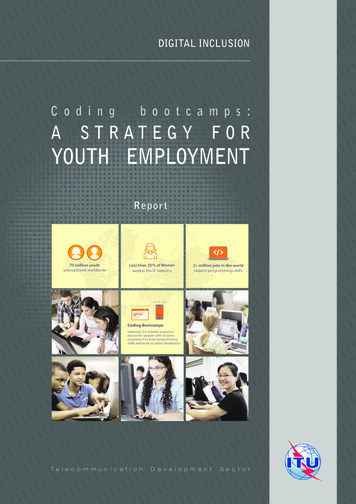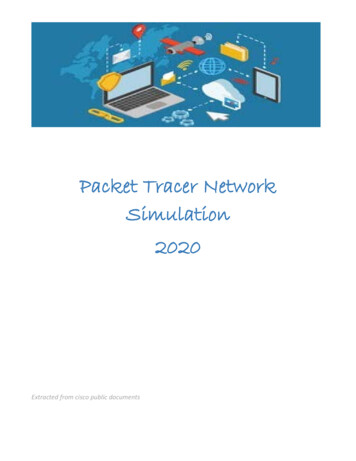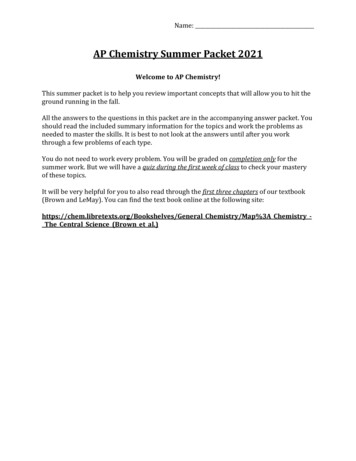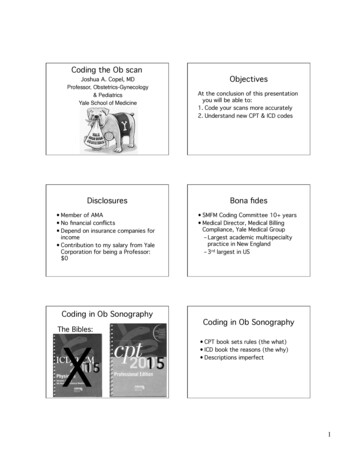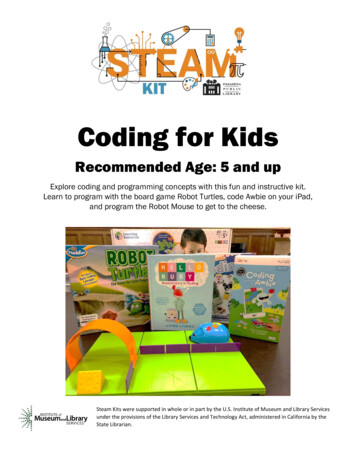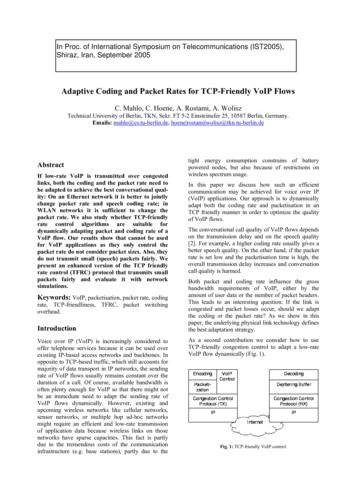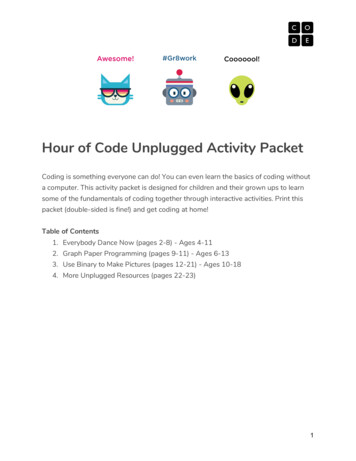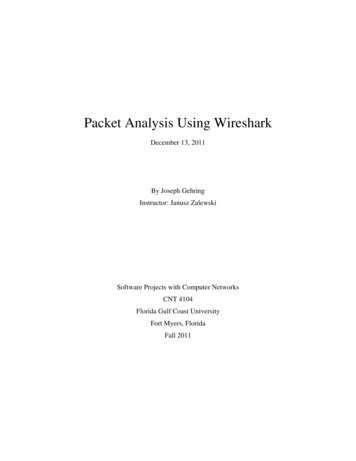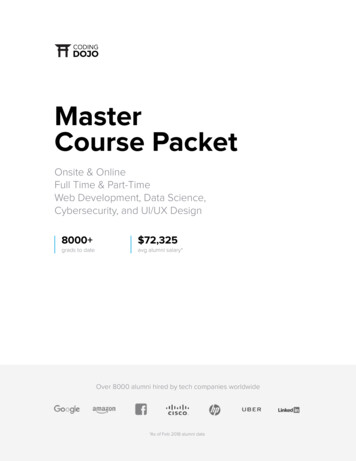
Transcription
MasterCourse PacketOnsite & OnlineFull Time & Part-TimeWeb Development, Data Science,Cybersecurity, and UI/UX Design8000 72,325grads to dateavg alumni salary*Over 8000 alumni hired by tech companies worldwide*As of Feb 2018 alumni data
OnsiteBootcamp14 Week Immersive Bootcamp3 Full Stack Curriculum8000 72,325grads to dateavg alumni salary*Over 8000 alumni, hired by tech companies worldwide*As of Feb 2018 alumni data
Onsite BootcampYour career as a software developerstarts on your first day in class.Within 14 weeks we’ll turn you into aself-sufficient, versatile developer whohas all the critical skills to have a long,healthy career in tech.Learn by DoingAnyone Can Learn to CodeYou’ll start coding from day one on campus.Dive into a fast, project-based learningenvironment that fosters collaboration,not competition.Anyone can learn to code, but the path to becoming a developer isn’t easy. The mostsuccessful students dedicate at least 70-90hours/week to the bootcamp.A Typical Day at the DojoActivities subject to change based on campus and curriculum
3 Full Stack CurriculumWe’re here to maximize your careeropportunities and coding mastery. You’lllearn 3 full stacks, have a portfolio to show,and 3x the job prospects.Level Up, Stack by StackWeb S3JavascriptjQueryPython 3OOPFlaskMySQLAjaxC#ASP.NET Core 2LINQDapperEntity FrameworkIdentityJava 8MySQLJSPsSpring Data JPASpring BootSpring SecurityJavascript m subject to change during attendance due to mid-course improvements
Web FundamentalsFront-End Development & The WebHTMLIntro to HTMLBasic Nesting Practices, IndentationThe Head & BodyBody Tags (lists, tables, etc.)Building Forms & Declaring Input ValuesContainers, Elements, Attributes, & ClassesCSSIntro to CSSCSS Selectors & DeclarationsInspecting ElementInline, Block, Float, and PositioningDiv Layout & FormattingStyling Text & How Fonts WorkUsing Properties & BackgroundsReplicating Complete User InterfacesIntro to CSS3 & More Styling*Building ShapesConstructing Complex TablesIntro to BootstrapCSS Preprocessors, LESS, & SASSGit / GithubGit & Version ControlUsing Terminal CommandsHow to Create & Utilize a RepositoryMaking, Tracking, & Reverting ChangesGit Workflow Overview & States*Advanced Git Commands & Concepts*Branching, Merging, & Conflicts**Optional topicsGithubHow to Use a Github RepositoryForking, Cloning, & Pulling*Github Collaboration & Workflow*jQueryIntro to jQueryjQuery Functions & DebuggingParameters & Getters/SettersEssentials of the jQuery LibraryAdvanced jQueryImplementing Dynamic ContentCallbacks in jQueryTraversing DOM ElementsForms in jQueryjQuery UI Library & More Libraries*Responsive Web Design*Intro to Responsive Web Design (RWD)Breakpoints, Units, & Media QueriesBasics to Typesetting & ScalingCross-device RWDGrid System, Fluid Grids, & Adaptive LayoutsCSS FrameworksResponsive TypographyUsing CSS Reset & BoilerpointWireframing*Balsamic OverviewWireframing Fundamentals
PythonFull Stack DevelopmentMySQLIntro to MySQLDatabase Design & RelationshipsEntity Relationship Diagrams (ERD)Database NormalizationMySQL Workbench & QueryingConventions & Common Data TypesHow to Use ERDsUsing a Database with Your UIRecreating ERDs*PythonIntro to PythonVariables, Data Types & Best PracticesUsing Strings & Built-in String FunctionsList Creation & ManipulationUsing Tuples & Built-in Tuple FunctionsHow to Use Dictionaries in PythonConditionals, Operators, & Nested LoopsConstructing Functions in PythonPython OOPIntro to Object Oriented ProgrammingCreating Objects & ClassesAdding Properties/Attributes to ClassesConstructing & Adding Methods to ClassesChaining Methods & Using Magic MethodsHow to Use Modules & Packages in PythonCreating Multiple ObjectsUpdating Methods with ‘Super’Python Test Driven Development (TDD)Unit Testing in Python & OutcomesHow to Use Assertions UsingTDD Methods: setUp & tearDown*Optional topicsAdvanced PythonHow to Use Multiple ArgumentsTernary Operators in PythonUsing LambdaOverriding Inheritance & PolymorphismUsing Composition Over InheritanceFlaskIntro to FlaskRouting in Flask ApplicationsBuilding & Using FormsRendering Templates & ViewsDelivering Static ContentThe Different HTTP MethodsImplementing Cookies & SessionsHidden Inputs & Form ValidationFlask w/ SQLImport, Export, & Connect Your DatabaseConnecting & Running Python Across FilesDatabase Communication & ValidationEncryption & Data Security BasicsDeploymentAmazon Web Services (EC2)LinuxPostgreSQL
JavaFull Stack DevelopmentJava FundamentalsJava SpringIntro to JavaSpring FundamentalsJava Development Kit InstallationExecuting Java ProgramsVariables, Data Types, & Type CastingControl Structures & ExceptionsJava OOPIntro to Object Oriented ProgrammingCreating Objects & ClassesMethods, Member Variables & ConstructorsOverloading & thisInheritance & PackagesAdvanced Java OOPUse of StaticInterfaces & Abstract ClassesAnnotationsJava BeansData Structures*Doubly Linked ListsTriesJava Web DevelopmentJava on the WebServlets & Web ContainersQuery ParametersJava Servlet PagesLight MVC PatternsSession & POST Patterns*Optional topicsSpring OverviewSpring Tool SuiteIntro to Spring BootSpring MVC AppsSpring Data I & IIMySQL ConnectionsRepositories & Spring Data - JPAPersistent Model AnnotationsRelationshipsAdvanced QueriesSpring SecuritySpring Security OverviewAuthentication & AuthorizationServlet API IntegrationSpring MVC IntegrationDeploymentAmazon Web Services (EC2)LinuxPostreSQL
MERNFull Stack DevelopmentJavaScriptFundamentalsDeclaring & Referencing VariablesVariable Hoisting in JavaScriptConditionals, Operators, & Nested LoopsUsing Arrays & Loops in JavaScriptObjects, Functions, & Function ScopingVariable Hoisting with ScopingReturn Statements in JavaScriptFunction HoistingJavaScript OOPHow to Use Object ConstructorsCommon Constructors: ‘This’ & ‘New’Private Methods & VariablesCreating Prototype Objects in JavaScriptBest Practices for JavaScript OOPExpress.JSRender Templates With Express View EnginesHTTP Methods: Forms, Data Tranfers, & RoutingSocket.ioApplications with Real-time CommunicationMongoDBMongoDB & MongooseMongoDB Overview, CRUD OpsIntro to MongooseDependencies in MongooseMongoose Communication with MongoDBMongoose MethodsData Validation with MongooseCreate Associations Between Mongo ObjectsRESTful Routing with Mongoose & ExpressAdvanced JavaScriptHow to Use CallbacksDelegating Functionality & Event HandlingNode.JSIntro to NodeHow to Use Package Managers (NPM/Bower)File System Module & HTTPMaking a Full Web SeverHow to Work with Node ModulesCommon & Useful Node ModulesModularizationUsing Require & Module.exportsHow to Modularize Existing Projects*Optional topicsReactCreate React AppClass Based ComponentsProps, Children, Synthetic EventsState, LifeCycle MethodsFunctional ComponentsuseState, useEffect, useReducercontext APIDeploymentAmazon Web Services (EC2)LinuxProduction EnvironmentsHeroku
C# .NETFull Stack DevelopmentC# FundamentalsObject Relational Mapping (ORM)Intro to C#Working with ORMs.NET Core Console ApplicationsVariables, Types, Type Casting, & FunctionsControl StructuresDebugging .NET Core Applications (VS Code)C# OOPIntro to Object Oriented ProgrammingClasses & ObjectsAccess ModifiersInheritance & PolymorphismEncapsulation with PropertiesAdvanced C# OOPInterfacesAbstract ClassesGenericsData StructuresSingly Linked ListsDoubly Linked ListsTriesASP.NET CoreDependency Injection with ASP ServicesMVC ArchitectureRazor View EngineView ModelingExtension MethodsCustom User Authentication/Authorization*Optional topicsLINQDapperEntity Framework CoreIdentity Framework CoreUser Authentication/AuthorizationIdentity RolesThird Party OAuthDeploymentAmazon Web Services (EC2)LinuxProduction EnvironmentsHosting with Nginx/Supervisor
OnlineBootcampFull-Time Online3 Full Stack Curriculum8000 72,325grads to dateavg alumni salary*Over 8000 alumni, hired by tech companies worldwide*As of Feb 2018 alumni data
Online Full-TimeNo matter where you are in the world,your career as a software developerstarts on your first day.Within 14 weeks we’ll turn you into aself-sufficient, versatile developer whohas all the critical skills to have a long,healthy career in tech.Hands-on, Structured TeachingAnyone Can Learn to CodeDive into an immersive online learning environment filled with live mentorship, instruction, andcollaboration with real instructors and classmates.Anyone can learn to code, but the path to becoming a developer isn’t easy. The mostsuccessful students dedicate at least 70-90hours/week to the bootcamp.All from the comfort of your own home.A Typical Day in the Online BootcampActivities subject to change based on campus and curriculum
3 Full Stacks OnlineWe’re here to maximize your careeropportunities and coding mastery. You’lllearn 3 full stacks, have a portfolio to show,and 3x the job prospects.Level Up, Stack by StackWeb S3JavascriptjQueryPython 3OOPFlaskMySQLAjaxJava 8MySQLJSPsSpring Data JPASpring BootSpring SecurityJavascript ES6MongoDbExpress.jsReactNode.jsSocket.ioC#ASP.NET Core 2LINQDapperEntity FrameworkIdentityCurriculum subject to change during attendance due to mid-course improvements
Web FundamentalsFront-End Development & The WebHTMLIntro to HTMLBasic Nesting Practices, IndentationThe Head & BodyBody Tags (lists, tables, etc.)Building Forms & Declaring Input ValuesContainers, Elements, Attributes, & ClassesCSSIntro to CSSCSS Selectors & DeclarationsInspecting ElementInline, Block, Float, and PositioningDiv Layout & FormattingStyling Text & How Fonts WorkUsing Properties & BackgroundsReplicating Complete User InterfacesIntro to CSS3 & More Styling*Building ShapesConstructing Complex TablesIntro to BootstrapCSS Preprocessors, LESS, & SASSGit / GithubGit & Version ControlUsing Terminal CommandsHow to Create & Utilize a RepositoryMaking, Tracking, & Reverting ChangesGit Workflow Overview & States*Advanced Git Commands & Concepts*Branching, Merging, & Conflicts**Optional topicsGithubHow to Use a Github RepositoryForking, Cloning, & Pulling*Github Collaboration & Workflow*jQueryIntro to jQueryjQuery Functions & DebuggingParameters & Getters/SettersEssentials of the jQuery LibraryAdvanced jQueryImplementing Dynamic ContentCallbacks in jQueryTraversing DOM ElementsForms in jQueryjQuery UI Library & More Libraries*Responsive Web Design*Intro to Responsive Web Design (RWD)Breakpoints, Units, & Media QueriesBasics to Typesetting & ScalingCross-device RWDGrid System, Fluid Grids, & Adaptive LayoutsCSS FrameworksResponsive TypographyUsing CSS Reset & BoilerpointWireframing*Balsamic OverviewWireframing Fundamentals
PythonFull Stack DevelopmentMySQLIntro to MySQLDatabase Design & RelationshipsEntity Relationship Diagrams (ERD)Database NormalizationMySQL Workbench & QueryingConventions & Common Data TypesHow to Use ERDsUsing a Database with Your UIRecreating ERDs*PythonIntro to PythonVariables, Data Types & Best PracticesUsing Strings & Built-in String FunctionsList Creation & ManipulationUsing Tuples & Built-in Tuple FunctionsHow to Use Dictionaries in PythonConditionals, Operators, & Nested LoopsConstructing Functions in PythonPython OOPIntro to Object Oriented ProgrammingCreating Objects & ClassesAdding Properties/Attributes to ClassesConstructing & Adding Methods to ClassesChaining Methods & Using Magic MethodsHow to Use Modules & Packages in PythonCreating Multiple ObjectsUpdating Methods with ‘Super’Python Test Driven Development (TDD)Unit Testing in Python & OutcomesHow to Use Assertions UsingTDD Methods: setUp & tearDown*Optional topicsAdvanced PythonHow to Use Multiple ArgumentsTernary Operators in PythonUsing LambdaOverriding Inheritance & PolymorphismUsing Composition Over InheritanceFlaskIntro to FlaskRouting in Flask ApplicationsBuilding & Using FormsRendering Templates & ViewsDelivering Static ContentThe Different HTTP MethodsImplementing Cookies & SessionsHidden Inputs & Form ValidationFlask w/ SQLImport, Export, & Connect Your DatabaseConnecting & Running Python Across FilesDatabase Communication & ValidationEncryption & Data Security BasicsPylot MVCIntro to Pylot Model View Controller (MVC)Views, Session Classes & Session DataHow to Use Models with ControllersData Validation with PylotUsing Bcrypt with Pylot MVCHow to Use Multiple Controllers & ModelsDeploymentAmazon Web Services (EC2)LinuxPostgreSQL
JavaFull Stack DevelopmentJava FundamentalsJava SpringIntro to JavaSpring FundamentalsJava Development Kit InstallationExecuting Java ProgramsVariables, Data Types, & Type CastingControl Structures & ExceptionsJava OOPIntro to Object Oriented ProgrammingCreating Objects & ClassesMethods, Member Variables & ConstructorsOverloading & thisInheritance & PackagesAdvanced Java OOPUse of StaticInterfaces & Abstract ClassesAnnotationsJava BeansData Structures*Doubly Linked ListsTriesJava Web DevelopmentJava on the WebServlets & Web ContainersQuery ParametersJava Servlet PagesLight MVC PatternsSession & POST Patterns*Optional topicsSpring OverviewSpring Tool SuiteIntro to Spring BootSpring MVC AppsSpring Data I & IIMySQL ConnectionsRepositories & Spring Data - JPAPersistent Model AnnotationsRelationshipsAdvanced QueriesSpring SecuritySpring Security OverviewAuthentication & AuthorizationServlet API IntegrationSpring MVC IntegrationDeploymentAmazon Web Services (EC2)LinuxPostreSQL
MERNFull Stack DevelopmentJavaScriptFundamentalsDeclaring & Referencing VariablesVariable Hoisting in JavaScriptConditionals, Operators, & Nested LoopsUsing Arrays & Loops in JavaScriptObjects, Functions, & Function ScopingVariable Hoisting with ScopingReturn Statements in JavaScriptFunction HoistingJavaScript OOPHow to Use Object ConstructorsCommon Constructors: ‘This’ & ‘New’Private Methods & VariablesCreating Prototype Objects in JavaScriptBest Practices for JavaScript OOPExpress.JSRender Templates With Express View EnginesHTTP Methods: Forms, Data Tranfers, & RoutingSocket.ioApplications with Real-time CommunicationMongoDBMongoDB & MongooseMongoDB Overview, CRUD OpsIntro to MongooseDependencies in MongooseMongoose Communication with MongoDBMongoose MethodsData Validation with MongooseCreate Associations Between Mongo ObjectsRESTful Routing with Mongoose & ExpressAdvanced JavaScriptHow to Use CallbacksDelegating Functionality & Event HandlingNode.JSIntro to NodeHow to Use Package Managers (NPM/Bower)File System Module & HTTPMaking a Full Web SeverHow to Work with Node ModulesCommon & Useful Node ModulesModularizationUsing Require & Module.exportsHow to Modularize Existing Projects*Optional topicsReactCreate React AppClass Based ComponentsProps, Children, Synthetic EventsState, LifeCycle MethodsFunctional ComponentsuseState, useEffect, useReducercontext APIDeploymentAmazon Web Services (EC2)LinuxProduction EnvironmentsHeroku
C# .NETFull Stack DevelopmentC# FundamentalsObject Relational Mapping (ORM)Intro to C#Working with ORMs.NET Core Console ApplicationsVariables, Types, Type Casting, & FunctionsControl StructuresDebugging .NET Core Applications (VS Code)C# OOPIntro to Object Oriented ProgrammingClasses & ObjectsAccess ModifiersInheritance & PolymorphismEncapsulation with PropertiesAdvanced C# OOPInterfacesAbstract ClassesGenericsData StructuresSingly Linked ListsDoubly Linked ListsTriesASP.NET CoreDependency Injection with ASP ServicesMVC ArchitectureRazor View EngineView ModelingExtension MethodsCustom User Authentication/Authorization*Optional topicsLINQDapperEntity Framework CoreIdentity Framework CoreUser Authentication/AuthorizationIdentity RolesThird Party OAuthDeploymentAmazon Web Services (EC2)LinuxProduction EnvironmentsHosting with Nginx/Supervisor
Part-TimeOnlineAccelerated and Flex Pacing2-4 Hours / Week in Lecture10-30 Hours / Week in Self-Study10-30 Hrs3 Stacks16 to 28 Wksper weekto choose fromflexible scheduleOver 8,000 alumni, hired by tech companies worldwide*As of Feb 2018 alumni data
Online Part-TimeIn 16 to 28 weeks, you can transition toa career in development without quittingyour day job.This program is a flexible alternative thatprovides full, online access to our Pythoncurriculum -- complete with live supportand collaboration with instructors andclassmates.Two Options to Fit Your ScheduleACCELERATED1625weekshrs/wkComplete webfundamentals, thenchoose from thefollowing stacks:FLEX2814weekshrs/wkComplete webfundamentals, thenstart PythonONLY Python isavailable throughFlex at this time.
ACCELERATEDLearn to build applications in the topprogramming stacks of 2020. Pick betweenPython, MERN, or Java as your stack, or chooseto extend the program and learn multiplelanguages.Your Progression PlanA Typical Week in the Part-Time ProgramActivities subject to change based on campus and curriculumAwards & Recognition
Time ManagementHere’s what a typical week might look like for someonewho continues to work full-time as well as participate infamily activities while in the Accelerated program.Pro Tips from Student SuccessOverestimate the time youneed for self-studyCreate a calendar and stickwith it!List out responsibilities and seewho can helpThe Part-Time Online programexpects you to dedicate at least20 hours per week in the learningplatform working through content.So, for the first few weeks, allocate24 hrs for that work. It is easier toscale back than scale up.It sounds simple, but a calendarcan be shared with family andfriends to help you stay accountable and to get insight into whenyou’re going to be heads down. Italso gives you a reality check intohow much time you actually spend.Create a list of your householdand family responsibilities. See ifyou can offload any tasks or getadditional help from housemates,friends, and family. If you’ll beworking during this time, do thesame exercise with coworkers.
FLEXThe same Python curriculum, over a longeramount of time, so you can manage the rest ofyour commitments more easily.Your Progression PlanWhether you choose Accelerated or Flex,we are here to support you.Hands-on, Structured TeachingAnyone Can Learn to CodeDive into an immersive online learningenvironment filled with live mentorship,instruction, and collaboration with realinstructors and classmates.Anyone can learn to code, but the path tobecoming a developer isn’t easy. Studentstypically dedicate 20-30 hours a week to selfstudy in the accelerated program, and 10-15hours in Flex.All from the comfort of your own home.Curriculum subject to change during attendance due to mid-course improvements
Web FundamentalsFront-End Development & The WebHTMLIntro to HTMLBasic Nesting Practices, IndentationThe Head & BodyBody Tags (lists, tables, etc.)Building Forms & Declaring Input ValuesContainers, Elements, Attributes, & ClassesCSSIntro to CSSCSS Selectors & DeclarationsInspecting ElementInline, Block, Float, and PositioningDiv Layout & FormattingStyling Text & How Fonts WorkUsing Properties & BackgroundsReplicating Complete User InterfacesIntro to CSS3 & More Styling*Building ShapesConstructing Complex TablesIntro to BootstrapCSS Preprocessors, LESS, & SASSGit / GithubGit & Version ControlUsing Terminal CommandsHow to Create & Utilize a RepositoryMaking, Tracking, & Reverting ChangesGit Workflow Overview & States*Advanced Git Commands & Concepts*Branching, Merging, & Conflicts**Optional topicsGithubHow to Use a Github RepositoryForking, Cloning, & Pulling*Github Collaboration & Workflow*jQueryIntro to jQueryjQuery Functions & DebuggingParameters & Getters/SettersEssentials of the jQuery LibraryAdvanced jQueryImplementing Dynamic ContentCallbacks in jQueryTraversing DOM ElementsForms in jQueryjQuery UI Library & More Libraries*Responsive Web Design*Intro to Responsive Web Design (RWD)Breakpoints, Units, & Media QueriesBasics to Typesetting & ScalingCross-device RWDGrid System, Fluid Grids, & Adaptive LayoutsCSS FrameworksResponsive TypographyUsing CSS Reset & BoilerpointWireframing*Balsamic OverviewWireframing Fundamentals
PythonFull Stack DevelopmentMySQLIntro to MySQLDatabase Design & RelationshipsEntity Relationship Diagrams (ERD)Database NormalizationMySQL Workbench & QueryingConventions & Common Data TypesHow to Use ERDsUsing a Database with Your UIRecreating ERDs*PythonIntro to PythonVariables, Data Types & Best PracticesUsing Strings & Built-in String FunctionsList Creation & ManipulationUsing Tuples & Built-in Tuple FunctionsHow to Use Dictionaries in PythonConditionals, Operators, & Nested LoopsConstructing Functions in PythonPython OOPIntro to Object Oriented ProgrammingCreating Objects & ClassesAdding Properties/Attributes to ClassesConstructing & Adding Methods to ClassesChaining Methods & Using Magic MethodsHow to Use Modules & Packages in PythonCreating Multiple ObjectsUpdating Methods with ‘Super’Python Test Driven Development (TDD)Unit Testing in Python & OutcomesHow to Use Assertions UsingTDD Methods: setUp & tearDown*Optional topicsAdvanced PythonHow to Use Multiple ArgumentsTernary Operators in PythonUsing LambdaOverriding Inheritance & PolymorphismUsing Composition Over InheritanceFlaskIntro to FlaskRouting in Flask ApplicationsBuilding & Using FormsRendering Templates & ViewsDelivering Static ContentThe Different HTTP MethodsImplementing Cookies & SessionsHidden Inputs & Form ValidationFlask w/ SQLImport, Export, & Connect Your DatabaseConnecting & Running Python Across FilesDatabase Communication & ValidationEncryption & Data Security BasicsDeploymentAmazon Web Services (EC2)LinuxPostgreSQL
JavaFull Stack DevelopmentJava FundamentalsJava SpringIntro to JavaSpring FundamentalsJava Development Kit InstallationExecuting Java ProgramsVariables, Data Types, & Type CastingControl Structures & ExceptionsJava OOPIntro to Object Oriented ProgrammingCreating Objects & ClassesMethods, Member Variables & ConstructorsOverloading & thisInheritance & PackagesAdvanced Java OOPUse of StaticInterfaces & Abstract ClassesAnnotationsJava BeansData Structures*Doubly Linked ListsTriesJava Web DevelopmentJava on the WebServlets & Web ContainersQuery ParametersJava Servlet PagesLight MVC PatternsSession & POST Patterns*Optional topicsSpring OverviewSpring Tool SuiteIntro to Spring BootSpring MVC AppsSpring Data I & IIMySQL ConnectionsRepositories & Spring Data - JPAPersistent Model AnnotationsRelationshipsAdvanced QueriesSpring SecuritySpring Security OverviewAuthentication & AuthorizationServlet API IntegrationSpring MVC IntegrationDeploymentAmazon Web Services (EC2)LinuxPostreSQL
MERNFull Stack DevelopmentJavaScriptFundamentalsDeclaring & Referencing VariablesVariable Hoisting in JavaScriptConditionals, Operators, & Nested LoopsUsing Arrays & Loops in JavaScriptObjects, Functions, & Function ScopingVariable Hoisting with ScopingReturn Statements in JavaScriptFunction HoistingJavaScript OOPHow to Use Object ConstructorsCommon Constructors: ‘This’ & ‘New’Private Methods & VariablesCreating Prototype Objects in JavaScriptBest Practices for JavaScript OOPExpress.JSRender Templates With Express View EnginesHTTP Methods: Forms, Data Tranfers, & RoutingSocket.ioApplications with Real-time CommunicationMongoDBMongoDB & MongooseMongoDB Overview, CRUD OpsIntro to MongooseDependencies in MongooseMongoose Communication with MongoDBMongoose MethodsData Validation with MongooseCreate Associations Between Mongo ObjectsRESTful Routing with Mongoose & ExpressAdvanced JavaScriptHow to Use CallbacksDelegating Functionality & Event HandlingNode.JSIntro to NodeHow to Use Package Managers (NPM/Bower)File System Module & HTTPMaking a Full Web SeverHow to Work with Node ModulesCommon & Useful Node ModulesModularizationUsing Require & Module.exportsHow to Modularize Existing Projects*Optional topicsReactCreate React AppClass Based ComponentsProps, Children, Synthetic EventsState, LifeCycle MethodsFunctional ComponentsuseState, useEffect, useReducercontext APIDeploymentAmazon Web Services (EC2)LinuxProduction EnvironmentsHeroku
Data Science &Machine Learningin PythonLearn Data Science Online in 16 WeeksPart-TimeCareer FocusLearn by Doingclass commitmentbuilt into curriculumreal projects, real dataOver 8,000 alumni, hired by tech companies worldwide*As of Feb 2018 alumni data
OverviewTake a deep dive into the fundamentalsof data science and machine learningin Python over 16 weeks. You’ll gain acomprehensive understanding of theentire data science process from end-toend, including data prep, data analysisand visualization, as well as how to applymachine learning algorithms to varioussituations or tasks.You’ll walk away with a project portfolioshowcasing your data science acumenas well as an understanding of one of thefastest growing job sectors out there.Designed for the Real WorldLearn By DoingHands-On TrainingA practical, accelerated curriculum designedfor you to fix real-work problems by buildingreal Data Science projects and solutions. You’lltackle over 100 interview-style questions so thatyou’re fully prepared for the job search.Learn modern Data Science through hands-onassignments, projects, and mentorship fromyour instructor. Lectures are always live. Youalso have to access to TAs.Core Concepts, Real Data-SetsEnd-to-End, Extensive CurriculumIn 16 weeks, you’ll learn the principle conceptsand technologies behind modern Data Science,and work on real data-sets and problems to putyour learning into practice.We’ll cover the full Data Science process andthe technologies to do the job, from data prepwith Python libraries, to data modeling inScikit-Learn, to visualization and presentation.
Data Science CurriculumPython & Machine LearningWEEK 1WEEK 5Python for Data ScienceIntro to Machine LearningLearn the Python fundamentals needed for datascience.What is machine learning and why should you usethe Python library Scikit-Learn for Machine Learning. Topics include types of machine learning,how to format your data to be acceptable for analgorithm, and how to train an algorithm.WEEK 2Manipulating and UnderstandingDataLearn how to load, clean, and manipulate datausing the Python library Pandas. Additionally, youwill learn the strengths and weaknesses of usingPython to manipulate data.WEEK 3Foundations of DataModelingBuild visualizations to not only understand yourdata, but also how to communicate results tostakeholders.WEEK 4Statistical InferenceLearn how to use Python to implement key statistical techniques and understand statistics better byexperimenting with Python on real-world datasets.This week concludes with a project to showcaseyour knowledge.WEEK 6Decision Trees & Random ForestsLearn about tree-based machine learning algorithms, how to tune them to maximize their performance, and the strengths and weaknesses ofeach algorithm. Additional topics include featureselection for machine learning, and comparingmachine learning algorithms.WEEK 7Logistic Regression andRegularizationLearn about the logistic regression algorithm andget a visual understanding of how the algorithmworks. Additional topics include: logistic regression for multiclass classification, L1 and L2 regularization, and hyperparameter tuning the algorithmslearned so far.WEEK 8Clustering AlgorithmsYou’ll learn about a host of clustering algorithms,how to tune them, and the strengths andweaknesses of each.
Data Science CurriculumPython & Machine LearningWEEK 9WEEK 13Dimensionality ReductionDatabase ArchitectureWhat is dimensionality reduction. How to use itfor data visualization, speed up machine learning algorithms, and understand your data better.Algorithms covered include Principal ComponentAnalysis (PCA).Become familiar with entity relationship diagrams(ERD) and learn the advantages of using arelational database. Learn intermediate SQLqueries to access and aggregate information.WEEK 14WEEK 10Gradient Boosting MachinesLearn what gradient boosting algorithms are, whythey are so performant, and how to get startedwith Kaggle competitions.WEEK 11Intro to ETLDevelop an understanding of the process ofextracting, transforming, and loading data.WEEK 15Introduction to StatisticsUsing SQL with PythonLearn tools for statistical analysis including measures of central tendency, variance and standarddeviation and comparing means.Working with databases is an essential part ofbeing a data analyst, data scientist, and dataengineer. This unit will cover how SQL and Pythonwork together.WEEK 16WEEK 12Explore model assumptions and how to test forthem. Apply this knowledge to choose the appropriate model for a data set.Intro to Deep LearningLearn about why deep learning has transformedindustries, various deep learning frameworks, andwhen to use deep learning techniques. Topicsinclude recurrent neural networks (RNN) and Convolutional Neural Networks (CNN).Model Assumptions
Part-Time OnlineCybersecurityBootcamp24 Weeks to a Cyber CareerPart-TimeCareer ServicesLearn by Doingclass commitmentIncluded50-75% Lab WorkOver 6,000 alumni, hired by tech companies worldwide*As of 2020 alumni data
OverviewThe importance of cybersecurity todaycannot be overstated. As our reliance ontechnology grows, there’s a correspondingneed to secure and defend networks anddata against leaks, theft, and attacks. That’sgood news for cybersecurity specialists the U.S. Bureau of Labor Statistics projectscybersecurity jobs will grow 31% through2029. In short, there’s job security incybersecurity.What You’ll GetTop Industry CertificationsLearn By DoingLearn skills applicable to certifications suchas the Network , Linux , Server , Cloud , andcertified Ethical Hacker (CEH)., and receivevouchers for CompTIA Security and CySA .Gain hands-on experience with a host ofpopular tools such as Wireshark, Kali Linux,Metasploit, and more within a sandboxenvironment.Cyber-Specific Career ServicesEnd-to-End, Extensive CurriculumReceive personalized career support froma dedicated cybersecurity career servicesmanager, an
Epress.js React Node.js Socket.io. Online Full-Time No matter where you are in the world, your career as a software deeloper starts on your rst day. . Essentials of the jQuery Library jQuery Intro to jQuery Balsamic Overview Wireframi

